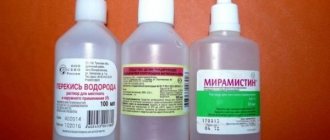Prevention
During the treatment of conjunctivitis, precautions should be taken to prevent re-development of inflammation
- Limit the child’s contact with a sick person, make sure that he does not touch the mucous membranes with dirty hands, toys, or household items.
- Refuse to attend children's educational institutions until complete recovery.
- During the treatment period, it is not recommended to visit baths, saunas, or swimming pools.
- To carry out inhalation for colds, special devices should be used. There is no need to use open containers with herbal infusions for inhalation. Hot water vapor helps to activate the inflammatory process.
- Before undergoing routine vaccination, you should consult your doctor.
How does conjunctivitis manifest?
Symptoms depend on the type of pathology. Conjunctivitis can be bacterial, chlamydial, viral, angular, fungal, allergic, dystrophic. Depending on the frequency of occurrence and severity of symptoms, inflammation of the conjunctiva can be acute or chronic. According to the nature of its course, conjunctivitis is divided into purulent, membranous, follicular, papillary, hemorrhagic, catarrhal. Each of these diseases has its own characteristics and symptoms. There are signs common to all types of conjunctivitis:
- swelling of the eyelids and connective membrane;
- conjunctival hyperemia;
- photophobia;
- pain in the eyes and a feeling of the presence of a foreign body in them;
- mucous or purulent discharge.
These symptoms can hardly be called specific. They are very common and appear with almost any eye disease of infectious or inflammatory etiology. A patient with inflammation of the mucous membrane may also experience headache, fever, cough, and runny nose. This happens with viral conjunctivitis. To list the specific symptoms of the disease, it is necessary to take a closer look at the various forms of its occurrence.
Features of the disease in children
In 80% of cases, inflammation is infectious in nature: the disease is caused by the development of viral or bacterial organisms. In rare cases, allergic and contact conjunctivitis occurs. They are caused by an allergy to a substance or a foreign body entering the eye.
Pus is a sign of the infectious nature of the disease.
Pathology can develop both in early childhood and adolescence. The disease is not dangerous, but only if you promptly contact an ophthalmologist and begin treatment.
Staying outside
Conjunctivitis is a transmittable disease, however, you should not completely give up walking. Symptoms of eye infection in children go away easier and faster than in adults. The kids ask to go for walks, and this is good, it means that the body is striving for recovery. Fresh air promotes recovery, in cases that are safe for a child or adult. You need to consider some rules before deciding whether you can walk with conjunctivitis.
- In case of an allergic form, contact with irritants should be limited as much as possible. The organs of vision are especially vulnerable during the flowering period of plants. It is better to sit out your sick time at home. In autumn, walks are possible when there is no pollen outside. In winter, the frosty air only worsens the situation, so it is advisable to go out for a walk only when the temperature is above zero.
- Bacterial and viral - often accompanied by weakness, fever, chills. If you have such symptoms, you should not go out into the air, as it can worsen the situation.
Squares and parks are suitable for walking. Exhaust gases are extremely harmful to the mucous membrane, so you should not walk near the roadway. Noticeable improvements in health after a walk mean that you can periodically go outside. It is worth considering some factors:
Walking may worsen the child's condition. Therefore, choose warm and windless weather, parks and squares with few people for walks.
- Subzero temperature. In winter, with severe frost, lacrimation and itching worsen, and pus discharge thickens;
- Wind. Dust, sand, and debris can get into your eyes with the air flow. These are strong irritants that will only complicate the treatment process;
- Rain and snow. Precipitation makes you cry. Such a walk will not do any good;
- Bright light. It irritates the eyes, especially when reflected from snow.
Lifestyle of a child with conjunctivitis: is it possible to bathe him or walk with him
Parents should understand that any eye irritation can complicate treatment and provoke pain. Therefore, when going out into the fresh air, limit/avoid negative factors as much as possible:
- bright and direct sunlight (doubly dangerous in winter, when reflected from snow/ice, and in summer, reflected from water);
- wind - it itself irritates the eyes and can bring dirt, sand or any other small foreign body into them;
- do not go out at any time of the year or day if there is precipitation outside, so that dirt does not get into your eyes along with water or snow;
- It is extremely undesirable to walk in severe frost (from -15-18 degrees), as this provokes lacrimation and thickening of purulent discharge (clogged ducts will lead to the formation of boils);
- Spring walks are also best avoided, since this is a period of severe vitamin deficiency, in which one infectious disease will provoke more serious illnesses or complications.
A good time to go for a walk is after lunch, in the late afternoon or, if we are talking about the little ones, during the daytime nap (but with mandatory sun protection).
Late evening hours are not recommended due to the fact that children’s eyes are tired during the day and there is natural irritation at the end of the day.
You should be extremely careful on hot (even if cloudy) summer days, when increased sweating leads to an increased risk of salt getting into the eyes, which will inevitably cause itching and new suppuration.
An equally important issue seems to be the choice of a place where to walk with children. It is desirable that these be parks or park areas, forests or less busy streets. In large cities, courtyards or playgrounds are considered the most favorable.
Find out whether it is possible to bathe children with conjunctivitis and how to do it correctly: https://mozhno-detjam.ru/kupat-rebenka-pri-konjuktivite.html
How to dress children for a walk with conjunctivitis?
As usual, according to the season, that is, a jacket is not needed in the heat, but in winter you can’t refuse a fur coat. Important attributes of clothing are: scarf, headdress (selected according to the season, but it is best to use hats with a visor). It is important to remember here that woolen items, if an allergic etiology of conjunctivitis is suspected, will have to be excluded from everyday use.
Adviсe
Treatment of conjunctivitis is always a difficult and protracted process, so walking, although very useful, is not harmful. Be wary of common physical symptoms of the disease, which in themselves may prevent you from leaving the house for medical reasons (fever, chills, coughing and sneezing).
With recurrent conjunctivitis, it is better not to walk at all until complete recovery.
Pediatric conjunctivitis
Conjunctivitis in children usually occurs in the same way as in adults. It is an inflammatory process of the mucous membrane of the eye. It is easy to suspect conjunctivitis:
- the child’s eyes turn red, the eyelids swell;
- the baby constantly tries to scratch his eyes;
- lacrimation increases, clear mucus or pus may appear, which forms crusts that stick together eyelashes and eyelids;
- general health worsens, sometimes body temperature rises.
Most often, conjunctivitis of an infectious nature occurs in children. In 80% of clinical cases, it is caused by viruses that are easily transmitted by airborne droplets. Also, conjunctivitis in a child can be caused by bacteria: children do not always keep their hands clean and bring dirt into their eyes.
Depending on the type of conjunctivitis, the doctor prescribes the necessary medications and procedures. Treatment can take from several days to a couple of weeks. Is swimming allowed during this period?
Pros and cons of swimming
Pediatricians do not strictly prohibit bathing during treatment of conjunctivitis in a child. On the one hand, water procedures help wash away pathogenic microorganisms from the baby’s skin, which can aggravate the course of the disease. In addition, the child may simply get very dirty, and in this case it is impossible to do without bathing.
But you need to remember that if the course of conjunctivitis occurs with an increase in temperature, then doctors strongly advise abstaining from water procedures. It is better to wait until the course of the disease takes a milder form.
High fever is usually observed with infectious conjunctivitis with the formation of pus.
Also, a viral type of disease is often combined with manifestations of ARVI: in this case, bathing will also have to be postponed until the child’s well-being improves.
Any children's hygiene product contains substances that, if they come into contact with the mucous membranes of the organs of vision, can increase inflammation and even provoke its relapse.
We are even talking about “tearless” shampoos, as well as antibacterial gel and soap. Although they kill bacteria, they have an aggressive effect on the inflamed tissue. You won't have to wait for anything good.
Therefore, the child’s eyes must be protected from the effects of such agents.
When deciding whether to bathe a child suffering from conjunctivitis, you should analyze his condition and the dynamics of the disease. Water procedures are unacceptable if the temperature is elevated or relief has only recently occurred.
If the child’s condition does not allow him to be bathed, then he can be rubbed with a towel soaked in warm water. For very young patients, wet sanitary wipes, always hypoallergenic, will be useful. It is desirable that they are not impregnated with flavorings.
How to properly bathe a child with conjunctivitis
Before starting water procedures, you should clean your eyelids of pus and mucus. To do this, use cotton pads, swabs or gauze swabs, which are moistened in a warm solution of furatsilin or chamomile decoction. You need to wipe your child's eyes gently, without force. All this will help minimize the risk of re-infection.
When bathing children, especially very young children, it is very difficult to prevent water and detergent particles from getting into their eyes.
Not every child will sit quietly in the bathtub throughout the entire procedure: he is interested in splashing around and playing.
Therefore, it is recommended to wash children while standing, holding the babies with your hands, or using a special bathing slide. You should wash your body no higher than the neck, paying attention to the groin area and armpits.
An older child can take a shower without raising the water jet above shoulder level. If there is still an urgent need to wash your hair, then you need to be as careful as possible. Diving goggles are a good way to protect yourself from splashes.
Source: https://zdorovo.live/okulist/obraz-zhizni-rebenka-pri-konyunktivite-mozhno-li-ego-kupat-ili-gulyat-s-nim.html
Basic Rules
Prevention is aimed at preventing the development of the inflammatory process. It will prevent you from becoming infected if someone close to you is sick with this disease and will prevent relapse of the disease in people who have already suffered from conjunctivitis.
At the first symptoms
If symptoms of the disease occur, you should consult an ophthalmologist as soon as possible. The measures that need to be taken depend on the type and form of the disease. The general treatment regimen is usually as follows:
The eyes are washed with antiseptics, for example, furatsilin. Even if the inflammation affects only one eye, both need to be washed. If inflammation is accompanied by strong purulent discharge, it is recommended to use drops: chloramphenicol, sodium sulfacyl. The crusts that form before the eyes must be removed and then washed. In most cases, drug treatment is required - the use of gels, creams, ointments, drops
Antibacterial, antihistamine, corticosteroids, NSAIDs, and artificial tears are prescribed. It is important to take care of strengthening the immune system - this will increase the body’s resistance and allow you to recover faster.
Bathing rules
Remember! In the absence of fever and other contraindications for bathing during conjunctivitis, parents, when caring for the hygiene of a small patient, must adhere to the following rules:
Before swimming, you need to carefully clean the mucous membranes of the eyes from secretions. For this purpose, cotton-gauze discs are used. They should be moistened in a solution of chamomile or furatsilin, and carefully treat the child’s eyes with light movements. This can reduce the likelihood of infection spreading.
To bathe an infant, you need to use boiled water to prevent a secondary infection from occurring. Even if you don’t plan to immerse your baby in water with his head, splashes can get on the baby’s face, so it’s better to be on the safe side.
Baths with decoctions of medicinal herbs, which have an anti-inflammatory and calming effect, will be useful. For example, string, chamomile, oak bark, nettle. To prepare an infusion of a medicinal plant, you need to pour 2 tablespoons of dry plant material with half a liter of boiling water. Leave for 30 minutes, strain, and then pour into the prepared bath. It is recommended to add a little potassium permanganate to the bathing water; it will prevent the spread of infection. But you need to be very careful to ensure that the potassium permanganate crystals are completely dissolved in the water, otherwise you can burn the child’s skin.
Infants are bathed in their arms to prevent their heads from immersing in water - this is contraindicated for conjunctivitis.
If a child needs to wash his hair, it must be done very carefully. At the same time, use a minimal amount of detergent so that the foam does not get into the child’s eyes.
It is better to bathe older children during conjunctivitis in the shower, and you need to wet the child up to the level of the shoulders and neck. If washing your hair is required, it is recommended to wear special diving goggles over your eyes.
After water procedures, you need to wipe the child dry. It is important to ensure that there are no drafts in the room, even if the disease is already in its final stages - the slightest draft can trigger a relapse.
Water procedures should be carried out in the evening, or preferably immediately before the child goes to bed, to avoid hypothermia and drafts.
It is prohibited to use children's facial cosmetics, even if they are hypoallergenic, during conjunctivitis. It is also not advisable to lubricate the child’s body with creams and lotions - the baby may rub his stomach or legs with his hands, and then touch his eyes.
After bathing the baby, all items that were used during the hygiene procedure should be washed well with soap and then doused with boiling water, the towel should be washed.
If you need to instill medications prescribed by a doctor into your child’s eyes, it is not advisable to do this immediately after bathing. After all, bathing accelerates blood circulation, and the effects of medications may increase. Therefore, it is better to wait half an hour and only then perform all the necessary manipulations.
In what cases should you not bathe?
In this case, bathing can only make the situation worse. Also, you should not bathe a little person with an elevated temperature and purulent discharge from the eyes.
Until these symptoms go away, it is recommended to use wet wipes and towels to wipe the skin.
As for swimming in pools, this is not prohibited in principle if you have conjunctivitis.
But you must understand that water can become a source of infection for other people, since the infection spreads well in the aquatic environment.
Chlorination of water cannot be a guarantee of safety, and in addition, the substances included in the disinfecting liquid can dry out the mucous membrane of the eyes, which will negatively affect the course of the disease.
When asked whether a patient with conjunctivitis can visit a bathhouse, doctors answer in the negative.
There is also a risk of infecting other people or contracting a secondary infection.
If you have conjunctivitis, you should not swim in water.
Is it possible to swim in the pool?
Visiting the pool is contraindicated as chlorine water can intensify the inflammatory process.
Visiting public places with conjunctivitis is contraindicated. Going to the pool is especially dangerous, since the water is purified with chlorine, which causes irritation of the mucous membranes of the eye and slows down recovery. Swimming also risks introducing bacteria into the organs of vision, which will intensify the inflammatory process. According to research, the most common pathogens found in public swimming pools are staphylococcus and streptococcus. The restriction applies to all types of conjunctivitis, including the allergic subtype.
When entering the pool, a person must be examined by a doctor or nurse. If signs of an inflammatory process in the conjunctiva are detected, the visitor will be legally denied entry into a public place due to the risk of infecting other people. It is recommended to inform the administration if a person with conjunctivitis is seen, and ophthalmologists also advise leaving the water.
After the complete disappearance of negative symptoms, it is recommended to postpone going to the pool for another 4-5 days, so as not to provoke a relapse of the disease. After swimming for 1 week, ophthalmologists advise, for preventive purposes, to apply lotions on the eyelids using black tea, lemon balm or calendula for 10-15 minutes. before bedtime.
Is it possible to bathe a child with conjunctivitis: when can you wash your hair and take a bath?
“Of course, you need to bathe. After all, the baby must be clean. This is one of the health factors
However, it is important to know the nuances of water procedures. There are general recommendations
But it’s best to consult a doctor personally.”
As soon as parents are faced with conjunctivitis in their baby, they think about whether it is possible to bathe the child. For parents of very young children, this issue is especially relevant, because at an early age children do not understand that they should not rub their eyes with dirty hands, and adults cannot always follow this.
Cool
Send
What kind of disease is this?
Conjunctivitis is an inflammation of the mucous membrane of the eye. Children are much more difficult to tolerate this disease. They lose their appetite, their sleep is disturbed, and the children begin to act up.
The main signs of mucosal inflammation:
- the eyelids are glued together, yellow crusts appear on them;
- after sleep, when opening the eyes, mucus and pus flow from them;
- the lower eyelid turns red and swells;
- there is a burning sensation in the visual organs, a feeling of a foreign body;
- The child is negatively affected by bright light - it hurts him to perceive it.
Features of the disease in children
In 80% of cases, inflammation is infectious in nature: the disease is caused by the development of viral or bacterial organisms. In rare cases, allergic and contact conjunctivitis occurs. They are caused by an allergy to a substance or a foreign body entering the eye.
Pus is a sign of the infectious nature of the disease.
Pathology can develop both in early childhood and adolescence. The disease is not dangerous, but only if you promptly contact an ophthalmologist and begin treatment.
Attend school or kindergartens
With this diagnosis, children do not attend educational institutions. This is due to several reasons. Firstly, bacterial conjunctivitis is transmitted by airborne droplets, so a sick child can infect healthy others.
Secondly, a sick child needs to limit contact with other children, since during this period children’s immunity weakens. Because of this, the healing process slows down, and in the worst cases, the disease worsens.
In this situation, it is best for one of the parents to take sick leave and stay at home with the baby.
Walks
It is allowed to go out into the fresh air, but this must be done with extreme caution. In order not to harm the child’s health, you need to adhere to the following recommendations:
- Avoid walking in bright sunlight, especially at lunchtime. It is also not recommended to go outside in snowy weather, as the sun's rays reflect off the snow or ice and hurt your eyes even more.
- Cancel walks in windy weather. Firstly, it irritates the mucous membrane of the eye. And secondly, the wind can bring dust or other small foreign bodies into your eyes.
- Do not organize walks during precipitation. Otherwise, dirt may get into your eyes along with rain or snow.
- Walking in severe frost is strictly prohibited. In this case, lacrimation will begin, and purulent discharge will thicken. Because of this, the ducts become clogged, which leads to the formation of boils.
- During spring vitamin deficiency, the body is already weakened, so you should avoid walking.
Bathing
In any case, you need to follow the rules of baby hygiene. However, how to do this correctly is decided taking into account the condition of the baby and the degree of his illness. There is no need to completely abandon water procedures, since this is the only way to cleanse children’s skin of accumulated dirt and dust.
Infectious conjunctivitis is characterized by increased body temperature and copious discharge of pus. In this case, it is better to refuse swimming until the disease reaches a milder stage.
During water procedures, you cannot use cosmetics: regular soap, shampoo or shower gel. They contain fragrances, fragrances and other chemicals that can cause allergies if they come into contact with the mucous membranes of the eyes. While bathing, make sure that your baby does not rub his eyes or splash water on them.
After taking a bath, you need to gently pat your skin without pressing on it. In this case, cosmetics are also not used.
Is it possible to go to the bathhouse with conjunctivitis: how to deal with eye inflammation, how to wash a child and an adult
Conjunctivitis is a group of diseases that can be caused by both infections and other factors.
In any case, the symptoms of conjunctivitis are not pleasant and visiting public baths and saunas with it can be uncomfortable and even dangerous. Cool
Send
What is worth knowing about the disease?
Conjunctivitis affects the eye area - it can occur in one eye or both, and manifests itself in the form of inflammation of the mucous membrane. Accompanied by unpleasant symptoms (itching, burning, discharge), it can be either contagious or completely harmless to others.
Main symptoms:
- redness of the eye area;
- itching in the eye area that does not stop after scratching;
- discharge;
- copious discharge of fluid from the mucous membrane during sleep.
Depending on the degree of the disease, a person suffering from conjunctivitis may experience different levels of discomfort, but all stages without exception can be treated. As a rule, the disease itself does not go away. Visiting public places with the disease is generally possible, since transmission of the infection (if any) requires close contact.
Most often, restrictions on visiting public places apply to children - at a young age, physical contacts constantly occur, unrestricted and frequent.
Basically, the restrictions regarding patients with conjunctivitis are quite conditional - the patient himself will not want to be exposed to the influence of the environment under the influence of infection, for fear of a deterioration in his health and progression of symptoms.
Acute conjunctivitis occurs solely due to infections that somehow reach the mucous membrane of the eye. The patient infects himself by trying to rub his eye or wipe it without washing his hands first.
The main causative agents of infection are the herpes virus and adenoviruses. Conjunctivitis is also caused by bacterial infections:
- staphylococcus;
- streptococcus;
- meningococcus;
- gonococcus;
- Pseudomonas aeruginosa.
All these organisms take root well in the mucous membrane of the eye, beginning to develop rapidly. Within a few days after infection, a person will begin to feel symptoms in full.
Infections get into the eye due to poor hygiene. In rare cases, when the infection comes from another person, trying to keep your hands clean may not prevent infection. In any case, close contact is required to transmit the virus or bacteria.
How it manifests itself
The symptoms of conjunctivitis are extremely specific and difficult to confuse with anything else. When an infection occurs, the patient experiences severe discomfort, and the quality of his daily life is greatly reduced. The patient loses part of his vision due to constant discharge, experiences itching and even pain.
The main symptoms of conjunctivitis:
- discharge from the eyes (may vary depending on the type of disease - from clear to purulent);
- discomfort in the eye area (itching and burning);
- redness of the eyes (both conjunctiva and eyelids);
- increased lacrimation (due to irritation of the membrane);
- swelling of the eyelids (swelling and “heaviness”).
Since these symptoms are extremely unpleasant and greatly interfere with any activity - rest, work, full social interaction, the patient notices them immediately.
In addition to the obvious inconvenience caused by the symptoms, conjunctivitis also greatly changes the appearance for the worse - despite the fact that the effect is temporary, many patients experience great problems with their daily tasks.
How should you behave if you are infected with conjunctivitis?
Despite all the discomfort the disease brings, many patients prefer to wait until it goes away on its own and do not try to quickly cure it, continuing to go about their daily activities.
It is clear that it is impossible for a modern person, especially a full-time employed person, to completely distance himself from people and his hygiene habits, but some rules of caution are still worth following.
Visit to the swimming pool
A swimming pool is a public place, which means that when visiting it, a person must comply with sanitary rules for general safety. In order to receive a subscription to the pool or a ticket for a single visit, the visitor must provide a certificate stating that he is not a carrier of infectious diseases transmitted by airborne droplets (and other contact routes).
Such precautions are logical and understandable - in the pool, people are vulnerable to infections, since they are in the same environment and surrounded by water, which greatly simplifies the exchange of viruses and other microorganisms between people. In the pool, visitors come into contact with water and surfaces with bare skin, accidentally swallow water and allow it to get into their eyes. Thus, a person with conjunctivitis is a potential threat to everyone else.
Since conjunctivitis has pronounced symptoms, such a patient will not be allowed into any pool where sanitary and hygienic standards are observed. The infected person may try to hide his illness in the early stages, when it is not so obvious, but this is an extremely undesirable act - in the pool there will definitely be people with weak immunity or children who will get sick because of this.
It is better for a patient with conjunctivitis to completely refrain from visiting the pool, even if he has the opportunity to be checked before entering - this will be the most correct thing to do, respecting the rights of other visitors.
Is it possible to wash your face if you have conjunctivitis?
No form of conjunctivitis is an obstacle to contact with water, and the washing procedure can remain in the same mode to which the patient is accustomed in his daily life.
The eyes do become more sensitive during illness, but washing them with running water will not harm them. For peace of mind, the patient can only wash himself with pre-boiled water, however, these measures do not contain any recommendations that must be followed.
You can also wash your eyes with water, but it is not effective. It is much better to use special medicinal solutions that are sold in pharmacies, including those in convenient containers.
How to wash your hair?
Washing your hair should also not change from the moment you become infected with conjunctivitis - there are no contraindications. However, the patient should be careful not to provoke a worsening of symptoms due to soapy water. To do this, precautions should be taken and, if possible, avoid any possibility of the substance getting into the eye.
How to properly wash your hair with conjunctivitis:
- Rinse your eyes - remove all discharge and instill the medicine, ensuring as little irritation of the conjunctiva as possible. Wait 5-10 minutes for better effect.
- Try to choose a shower that is close to contrast - you should not set up a steam room in the bathroom.
- Close your eyes well and begin to moisturize your hair by throwing it back. After several attempts, you will be able to ensure that the water does not flow onto your face.
- Add shampoo and begin your standard hair washing routine. If you can’t wash them by tilting them back, then use the standard method, tightly closing your eyes.
Keep a rinse solution ready so that if shampoo does get into your eye, you can wash it out immediately. Do not try to do this with water; soap cannot be easily washed off the mucous membrane.
Is it possible to walk outside?
You can go outside with any type of conjunctivitis, but how comfortable it will be for the patient himself is an individual question. Of course, if there is no choice and the patient needs to go to the store, to the doctor, etc., then he can and should go out. For a simple short walk, illness is also not an obstacle - there is no reason to deprive yourself of fresh air.
What conjunctivitis will definitely interfere with is meeting people. Dating with friends and partners, visits to relatives and other social events will have to be postponed until better times.
Firstly, eyes infected with conjunctivitis require constant care, which cannot always be carried out “in the field.” Even in cases where this is possible, the need to instill and wash your eyes every half hour or hour right on the street, or in the toilet of a cafe or in transport, will greatly distract from the original purpose of a meeting or walk.
There is also another factor that is significant not only for women, but also for men - this is appearance.
Not only will eyes with conjunctivitis not be able to withstand any makeup or contact lenses, but the overall face looks swollen and unattractive, which only increases the increased production of tears.
It is undesirable to resolve your affairs, both personal and business, in this form, especially if the interlocutors barely know each other.
Source: https://proglaza.net/lechenie/mozhno-li-v-banyu-s-konyuktivitom
Bathing rules
In order for water procedures to be beneficial and not harmful, you must follow the following rules:
Before swimming, wash your eyes. To do this, you need to moisten two cotton pads (separate for each eyelid) in furatsilin, weak tea leaves or chamomile decoction.
Gently rub your eyes from the inner corner to the outer corner. Bathe your child in the shower, do not draw a bath. Try not to pour water above shoulder level so that it does not get on your face. Pay special attention to the armpits and groin area, because
most bacteria accumulate in these areas. After the procedure, you should immediately dry the baby and dress him, avoiding drafts. It is best to do this in an already heated bathroom. After washing, let the child rest in bed under a warm blanket. It is recommended to wear warm socks.
How to wash your hair
It is advisable to avoid washing your hair if you have conjunctivitis. If there is an urgent need for this, then you can perform the procedure no more than once every 5 days. When washing your hair, avoid using shampoo; it is better to give preference to herbal decoctions. They will wash away dirt and will not harm your eyes.
Rice. 2. As an additional measure of protection, the use of swimming goggles is recommended.
Swimming in reservoirs
Natural bodies of water contain a huge number of infectious agents. They can penetrate the child’s weakened body and begin their life activities there.
This will not only slow down the treatment of conjunctivitis, but will also worsen the health condition.
Is it possible to take a bath with conjunctivitis?
Going to the bathhouse if you are ill is undesirable for the following reasons:
- there is a favorable environment for the proliferation of pathogenic microorganisms;
- high temperature and humidity worsen tear production, which cleanses the conjunctiva of pathogens;
- there is a risk of infecting others or becoming infected with an additional infection;
- high temperature promotes blood flow, which provokes even more severe inflammation;
- a weakened body may not be able to withstand the load that occurs when going to the steam room, because of this, various pathological conditions may appear.
Rice. 3. Going to the bathhouse can be resumed after the child is completely cured.
Time for a swim
Water procedures for conjunctivitis should only be a method of cleansing. Do not keep your child in water for too long.
Bathing should not last more than 10-15 minutes. It is best to wash your baby in the evening before bed, so that he can then go straight to a warm bed.
Bathing and feeding
Babies should not be bathed on an empty stomach because they will be fussy. If the baby is breastfed, you can feed him and immediately go to wash, and do this immediately after water procedures.
This is due to the fact that breast milk is better absorbed. If the baby is bottle-fed, then you need to wait at least 30 minutes between food and bathing. The same applies to children who are already eating adult food.
Bathing in the herbs
For conjunctivitis, it is recommended to wash the child not with ordinary water, but with a decoction of medicinal herbs. For example, from chamomile, string, nettle, oak bark. These plants have antiseptic and antibacterial effects. How to cook:
- 2 tbsp. l. herbs pour 0.5 liters of boiling water.
- Leave for 2-3 hours.
- Strain and add to bathing water.
Why are some people against
Most people refuse to take a bath or shower when they are sick, fearing hypothermia after warm water procedures. If you feel unwell, you should not wash yourself forcibly. But prolonged skin contamination leads to trouble. If you bathe your baby in warm water, then wipe him dry and dress him well, he will not have time to freeze.
So if your health allows, then you can bathe a child with conjunctivitis. It is important to follow simple rules. However, situations are different, and informational information does not replace consultation with a specialist.
Additionally, watch the story about the prevention and treatment of conjunctivitis in children, says a pediatric ophthalmologist:
Share our article with your friends. We look forward to your comments with your experience. All the best.
Will swimming be beneficial?
During conjunctivitis, parents need to take good care of their child's hygiene. Only a doctor can give recommendations regarding water procedures based on the condition of the small patient. In most cases, swimming is allowed, but only taking into account the characteristics of the disease.
Thanks to water procedures, dirt and infectious bacteria can be removed from the surface of the skin. If inflammation of the mucous membrane is accompanied by purulent discharge and elevated body temperature, then you must avoid swimming until the listed symptoms go away. The same recommendations should be followed in the presence of viral or cold conjunctivitis. In such situations, wet wipes or towels are used to dry the skin.
It is necessary to wait until the conjunctivitis takes a mild form and only then take a shower.
During treatment, it is not recommended to wash the child with shampoos, gels and even soap. Fragrances and other components of these substances can adversely affect the condition of a child's skin. In some cases, children's cosmetics cause an allergic reaction and the recurrence of conjunctivitis. Parents will need to ensure that water does not get into the child's eyes and that he does not rub them with his fingers while washing. Otherwise, this may lead to worsening of the condition or re-inflammation.
In situations where inflammation of the conjunctiva does not cause elevated body temperature, herbal decoctions are used and added to the filled bath. For these purposes, you can use chamomile or string, as they have an antibacterial effect.
The selected plant is pre-brewed and infused, after which it is filtered. It is best to add the decoction to the water in the evening so that the child sleeps well.
Swimming with conjunctivitis
Caring for a small child involves following the rules of personal hygiene. With the development of childhood conjunctivitis, many parents are concerned about the question: is it possible to bathe a child with conjunctivitis? Experts recommend performing water manipulations taking into account the baby’s condition and the complexity of the disease.
You should not categorically refuse water manipulations. Bathing is the main way to remove infectious bacteria, dirt, and dust from the surface of the skin.
Infectious conjunctivitis is accompanied by high body temperature and purulent discharge from the eyes. It is recommended to refrain from swimming until the disease reaches a milder stage.
The disease can develop on the basis of a cold or viral disease. With this form of the disease, you should not resort to bathing until the child’s condition returns to normal.
Important! To cleanse a child’s skin, it is recommended to use a soft towel and unscented wet wipes.
During the treatment process, you must refrain from using children's cosmetics for bathing: shampoo, gel, soap. They contain various chemical components, flavors, and fragrances that have an aggressive effect on the baby’s delicate skin.
If the product gets on the mucous membranes, an allergic reaction may occur, the inflammatory process may intensify, and resume. It is necessary to ensure that water does not get into the baby’s eyes, and the child does not rub his eyeballs with his hands during the bathing process.
Washing your hair with conjunctivitis - pros and cons
Since even the most harmless eye inflammation goes away in three days, this is not a reason to neglect the rules of simple hygiene and experience discomfort. Therefore, to the question: is it possible to wash your hair with conjunctivitis, the general rule applies - bathe only with boiled water and do not get it or shampoo into your eyes. If your hair is long, ask your loved ones to help you so that the procedure is quick and painless,
As in any life situation, exceptions are possible, for example, the patient’s well-being is accompanied by fever or a concomitant illness. It is necessary to decide depending on the condition - it may be better to postpone swimming with conjunctivitis until the next day, so as not to inadvertently worsen the situation.
If you find an error, please select a piece of text and press Ctrl+Enter.
Treatment of conjunctivitis in a child
It is necessary to exclude contact between healthy children and patients with conjunctivitis (especially if it is a bacterial or viral form of the disease). Treatment must certainly be prescribed by the appropriate specialists - a pediatrician and a pediatric ophthalmologist. Under no circumstances should you self-medicate. The application of blindfolds or any compresses is strictly prohibited. This will only create favorable conditions for the active reproduction of bacteria and viruses. The inflammatory process will not only not decrease, but, on the contrary, will intensify.
Children who have been diagnosed with viral or bacterial conjunctivitis need to wash their eyes every two hours with a warm anti-inflammatory solution of furatsilin; you can also use chamomile decoction. If there are dried crusts, they should be removed using cotton pads soaked in this solution. After rinsing one eye, the disc must be changed. After rinsing, apply the drops prescribed by the doctor, slightly pulling the eyelids.
If only one eye is inflamed, both need to be washed and instilled, because the inflammation can easily spread to the healthy eye. During the acute phase of the disease, 2-3 drops should be instilled into each eye every 2 or 3 hours. If eye ointments have been prescribed, the frequency of their use is recommended to be the same. When the severity of the disease decreases, you can gradually reduce it to 3 times a day until complete recovery.
Danger of visiting
By wearing slippers in the shower, a person will protect himself from additional infection against the background of decreased immunity.
The risk of worsening the condition increases if you share towels and hats. Also, when visiting the shower, you must wear slippers, since with conjunctivitis, the immune system is weakened and the risk of becoming infected with other pathogens increases. Styes and chalazions may form on the eyelids, releasing purulent masses. Ophthalmologists warn that if you go to the bathhouse during an acute inflammatory process in the eyes, the following complications and unpleasant symptoms may occur:
- redness of the skin of the eyelids;
- pronounced vascular network;
- increased inflammatory process;
- acute pain syndrome in the eyes;
- hemorrhage in the cornea, sclera or retina;
- increased itching and burning in the eyes;
- blurred vision;
- increased intraocular pressure.
If you cannot avoid visiting the sauna, then before and after the procedure you should drip your eyes with Albucid, Interferon, Vitabact or Erythromycin. Stay in a hot room for a minimum time. At the slightest blurred vision or increased itching, burning, or pain, you must leave the sauna. In the evening, you should put lotions of cold black tea, chamomile or lemon balm on your eyelids.
In the sauna you can catch sauna conjunctivitis of an infectious nature, transmitted through sauna products - towels, brooms, hygiene products.
During a visit to a public bath, a doctor and nurse must interview and examine the visitor. If they are diagnosed with infectious or bacterial conjunctivitis, they may refuse to use the steam room so as not to put others at risk. If symptoms of the disease were noticed in one of the visitors, the administration of the bath complex should be notified.
Bathing for conjunctivitis in a child: pros and cons
Pediatricians and ophthalmologists do not establish strict prohibitions on swimming for infants or older children who have been diagnosed with conjunctivitis. But the decision about whether you can wash your baby or not yet must be made after weighing the pros and cons.
The positive aspects are that during the washing process you remove impurities and microbes from the surface of the body, which can aggravate the inflammatory process and hinder healing. Another plus is that a washed child feels more comfortable, is less capricious and tolerates illness more easily. Of the negative aspects of bathing with conjunctivitis, the following can be noted. If a child washes with a high body temperature, then his condition after water procedures may noticeably worsen. In addition, bathing products (shampoos, gels) irritate inflamed tissues and can aggravate the symptoms of conjunctivitis or even cause a relapse of the pathology.
Bathing for conjunctivitis in a child: pros and cons
Pediatricians and ophthalmologists do not establish strict prohibitions on swimming for infants or older children who have been diagnosed with conjunctivitis. But the decision about whether you can wash your baby or not yet must be made after weighing the pros and cons.
The positive aspects are that during the washing process you remove impurities and microbes from the surface of the body, which can aggravate the inflammatory process and hinder healing. Another plus is that a washed child feels more comfortable, is less capricious and tolerates illness more easily. Of the negative aspects of bathing with conjunctivitis, the following can be noted. If a child washes with a high body temperature, then his condition after water procedures may noticeably worsen. In addition, bathing products (shampoos, gels) irritate inflamed tissues and can aggravate the symptoms of conjunctivitis or even cause a relapse of the pathology.
Pros and cons of swimming
The positive effects of taking a bath during illness include the elimination of pathogenic organisms.
To decide whether to take a bath or shower with conjunctivitis, it is recommended to evaluate the pros and cons, which are presented in the table:
| Positive effect | The dangers of water procedures |
| Elimination of pathogenic organisms | Increased inflammation |
| Body temperature jump | |
| Destruction of the environment conducive to the growth of bacteria | Acute pain syndrome and irritation of the conjunctiva when exposed to hygiene products |
| Increased risk of disease recurrence | |
| Increased secretion of pus and mucous masses | |
| Improved appearance | Increased risk of colds due to weakened immunity |
| The likelihood of hemorrhage due to a burst vessel in the eye | |
| Elimination of unpleasant odor | Possibility of an allergic reaction to shampoo, shower gel or soap |
How to wash a child with conjunctivitis correctly?
If you doubt whether it is possible to wash with conjunctivitis of a certain form and severity, be sure to consult an ophthalmologist. Most often, in case of fever and high temperature, doctors recommend postponing water procedures until the baby’s condition improves. During the severe stage of the disease, a shower and a warm bath can be replaced by wiping. To do this, simply wet a soft towel with warm water and gently wipe your baby's body with it.
If there is no temperature, the baby feels normal and the specialist has given permission to bathe the child, then when carrying out water procedures, follow some rules that will help avoid complications.
If a child has purulent conjunctivitis, then before bathing you need to first clear the eyes of discharge. To do this, use a cotton swab dipped in chamomile decoction, saline solution or furatsilin solution. By removing purulent discharge from the eyes, you will reduce the risk of re-infection and spread of infection. For infectious conjunctivitis, it is best to bathe your child in the shower. You should not run a bath, because through water, microbes from the eyes can spread to other mucous membranes and cause ARVI or other diseases. When your child washes, be sure to ensure that water does not get into his eyes. Tap water, in addition to various microorganisms, often contains chlorine and other substances that, if they get on the mucous membrane, can cause irritation, pain, and redness. For the same reason, do not allow your child to rub his eyes with wet hands. If you are bathing a baby, you can avoid getting water in the eyes by placing the child on a special children's bathing slide. You can also ask for the help of a second adult who will hold the child's head while you gently wash his body. Older children simply need to keep the shower below shoulder level. The most difficult task when bathing is to wash your hair so that water and shampoo do not get into your eyes. If it is impossible to postpone washing your hair until complete recovery, experts recommend using safety glasses or special caps that prevent water from getting into your eyes.
It is important to remember that glasses must be treated after water procedures, because pathogenic microorganisms could remain on them. After bathing, you need to dry your child with an individual towel that is not used by other family members. The best option is to replace the towel every time the baby uses it. Do not start using drops and ointments for conjunctivitis immediately, but at least half an hour after bathing.
How to bathe a baby
Conjunctivitis is an inflammation of the conjunctiva, the membrane lining the eyelid and part of the eyeball. It is most often caused by bacteria, viruses or an allergic reaction. Treatment of conjunctivitis places restrictions on habitual activities such as bathing.
If you follow some rules, you can safely bathe a child with conjunctivitis:
- While swimming, you should not wash your face and eyes, or pour water into your face. The nose, cheeks and chin are wiped with a damp cloth after bathing.
- If you have conjunctivitis, blindfolding is prohibited.
- If water gets on your face, blot it with a separate clean towel rather than drying it.
The child can be washed in the shower or gently bathed in the bath, leaving the face dry. For a baby who does not yet know how to sit or stand confidently, an anatomical bathtub is suitable.
When bathing, you can wash your child with special baby soap, gels, foams, which are sold in children's stores. The main thing is to make sure that they do not get into your eyes.
For skin problems, special pharmacy baby care products can help. Before bathing your child in a decoction of herbs such as chamomile and sage for the first time, it is better to consult a doctor, especially if the child is very young.
After evening bathing, the eyes are cleaned - rinsing and instilling drops in accordance with the recommendations of the ophthalmologist. Everything should be done only with clean hands; First one eye is treated, then the other, a separate cotton pad is used for each eye.
First, with a cotton pad soaked in warm boiled water, the discharge, crusts from the eyelids and eyelashes are carefully removed, and then the drops are instilled. Excess moisture is blotted with a clean, dry cotton pad or towel. This is a standard eye care regimen for conjunctivitis. At the appointment, the ophthalmologist explains in detail to parents what to do in each specific case.
Viral conjunctivitis
Inflammation of the mucous membrane of the eye can occur when adenoviruses, herpes, and trachoma enter the body. Adenoviral conjunctivitis is more common. This pathology lasts for several days like a common cold or acute respiratory viral infection. The patient's body temperature rises, cough and runny nose, and sore throat appear. After a few days, the disease affects the organs of vision. This disease is one of the most contagious, since the adenovirus is transmitted from person to person not only through household contact, but also through airborne droplets. It is recommended to isolate the patient. Contact with him or his personal items is not recommended.
Adenoviral diseases are accompanied by an increase in body temperature. Is it possible to take a steam bath with this type of conjunctivitis, go to a bathhouse or sauna. This will cause the temperature to rise even more. With this disease, it is not always possible to just take a shower. It is better to be patient for a while so that the condition does not worsen. If adenoviral conjunctivitis takes on a catarrhal form, it will go away quickly. Its symptoms are not severe.
In a film inflammatory process, which is rarely diagnosed, thin transparent formations form on the mucous membrane. They are removed with a cotton pad. In severe cases, the films become denser. Attempts to remove them lead to the formation of scars. Follicular conjunctivitis is characterized by the appearance of blisters on the mucous membrane. If they open, a clear or grayish liquid flows out.
What can influence the doctor's decision?
Since conjunctivitis appears as a consequence of a systemic disease, such as ARVI, the patient may have symptoms of the underlying disease. If general weakness of the body, chills, fever appear, or symptoms of any disease develop against the background of conjunctivitis, then both the adult and the child are strictly prohibited from leaving the house.
If a child or adult has developed allergic-type conjunctivitis, then going outside will most likely worsen the illness, since the patient will again encounter various allergens in the fresh air. This could be flowering plants, their pollen, any man-made allergen (lead fumes, etc.).
But if a patient is diagnosed with infectious conjunctivitis, then he can fearlessly leave the house, but he should not be in crowded places, otherwise other men and women will become infected.
Types of conjunctivitis
Human eyes are very sensitive to various irritants: strong wind, dust, cold or sunlight. With conjunctivitis, there is a sharp increase in sensitivity. Therefore, the patient should not walk in hot weather, in the cold, or during windy conditions. When it's hot, you produce sweat that can get into your eyes.
Since sweat secretions contain salts, this can cause irritation in the patient, which will lead to increased release of pus. When there is wind or severe frost, your eyes can become dry and dust can get into them. All this increases the symptoms of conjunctivitis.
If a child is sick, then parents should walk with him separately from other children. Conjunctivitis is considered a contagious disease, so it can be spread to other children through the air or through contact
If the baby has allergic-type conjunctivitis, then such precautions are not needed
For walks, you need to choose places like a forest park, a square, where there are no dangerous factors such as car exhaust or dust. Here the patient will be protected from sunlight or wind. But these recommendations are only suitable for infectious conjunctivitis.
Differential diagnosis of forms of conjunctivitis
Causes
Why do children attending kindergarten suffer from conjunctivitis much more often than other groups of the population? This phenomenon is due to the characteristics of children's socialization. As a rule, the baby continues to communicate with his group mates, spreading the disease through direct contact or airborne droplets. Touching, sharing toys, dishes - all this leads to infection of a large number of contact persons.
In addition, the development of conjunctivitis is promoted by:
- Violation of sanitary and hygienic standards in a preschool institution.
- Unsanitary home conditions and poor personal hygiene.
- Dry indoor air.
- Too bright artificial light.
- Improperly formulated diet (lack of nutrients and vitamins).
Note! Most often, preschool children suffer from bacterial conjunctivitis, caused by staphylococci, pneumococci or streptococci. As for viral conjunctivitis, in children it develops against the background of influenza, herpes, measles, chickenpox, adenovirus or enterovirus infection
As for viral conjunctivitis, in children it develops against the background of influenza, herpes, measles, chickenpox, adenovirus or enterovirus infection.
Allergic conjunctivitis is a constant companion to 90% of all allergic reactions: to dust, pollen, medications, food, etc.










